
This article first appeared in the journal Exhibition (Spring 2023) Vol. 42 No. 1 and is reproduced with permission. www.name-aam.org. If you don’t read the journal, learn how you can subscribe to Exhibition to receive your copy of the full upcoming issues.
In 2007, the Children’s Museum of Pittsburgh made a small bet on a big idea: invite four artists to the museum and give them time, space, and money to make an artwork “tough enough” to withstand the rigors of an interactive children’s museum. The success of this experiment led to the establishment of an ongoing annual summer artist-in-residence program called Tough Art. In addition to generating new artworks, the program provides opportunities for artists to work collaboratively with museum professionals to create an engaging work of art that is exhibited in the Museum alongside other interactive artworks and exhibit components. During the program’s 15-year history, 71 artists–working as individuals or in teams of two–have produced 60 artworks. The budget has grown and shrunk depending on what is happening at the Museum and in the world, but money has never been the leading factor in defining the residency experience. Instead, the residency focuses on the people–artists, staff, and visitors, especially young children. Everyone involved is challenged to take risks by reconsidering what it means to present museum-quality artworks to an audience that approaches art in unpredictable and unexpected ways and to do so with a limited budget.
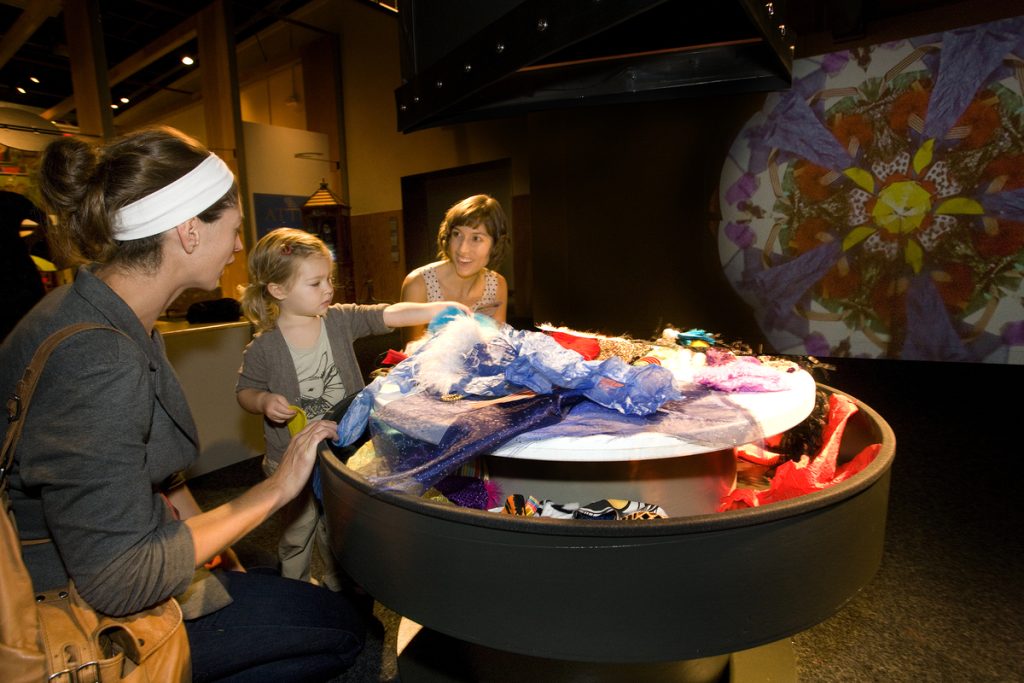
Art and Kids Sharing Space
Art is at the center of the visitor experience at the Children’s Museum of Pittsburgh. Artists are routinely invited to share both their processes and products with visitors and staff, contributing to a creative culture that respects children as an audience capable of engaging in conversations about big ideas. Involving artists in the development of exhibits is one way we “stay fresh” and hold ourselves accountable to our goals of delivering innovative content, learning new skills, and challenging our constructs of what exhibits for children should be. From this perspective, embedding contemporary art and artists into the daily life of the Museum benefits everyone involved because it challenges us, as museum professionals, to think differently about our work. This practice also advances the Museum’s mission to provide innovative and inclusive museum experiences that inspire joy, creativity, kindness, and curiosity (fig.1). It is from this physical and conceptual environment that the Tough Art residency was born.
What Is Tough Art?
In 2004, the Museum commissioned 12 artworks as part of a multimillion-dollar capital expansion project. After observing the positive impact those artworks had on the visitor experience, we knew that interactive art was our “secret sauce,” but finding artists who had the experience to produce works for a hands-on environment was not a simple prospect. We posited the idea of an artist residency that would not only result in new artworks, but also provide artists a space to learn firsthand what it takes to make an artwork tough enough to withstand the rigors of extensive hands-on–and sometimes aggressive–visitor use, and to do so in a way that was financially sustainable for the Museum (fig. 2).
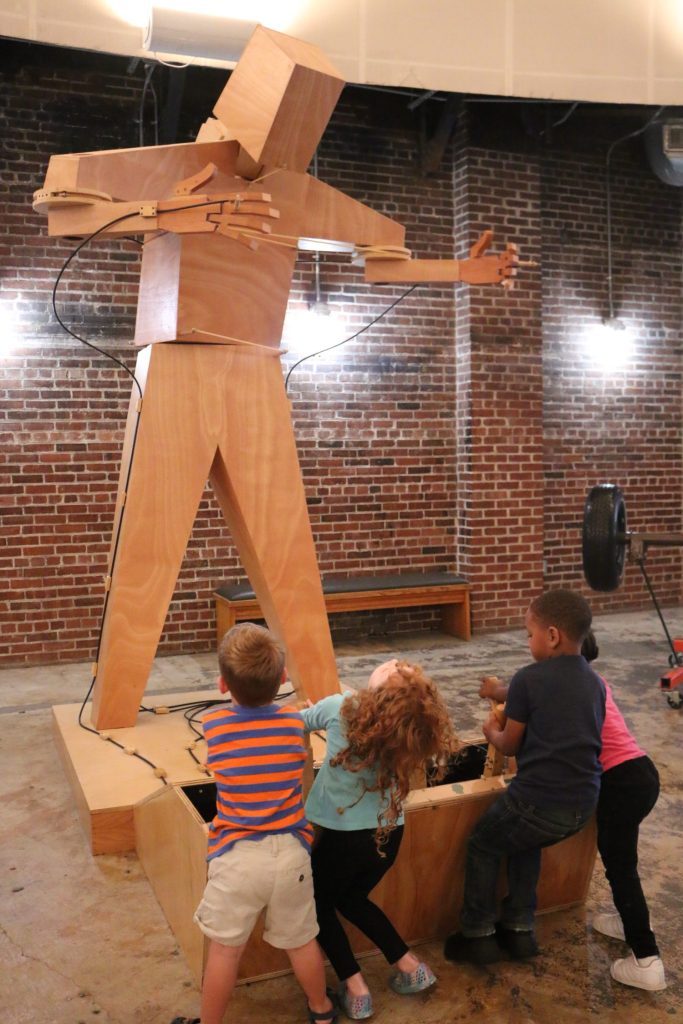
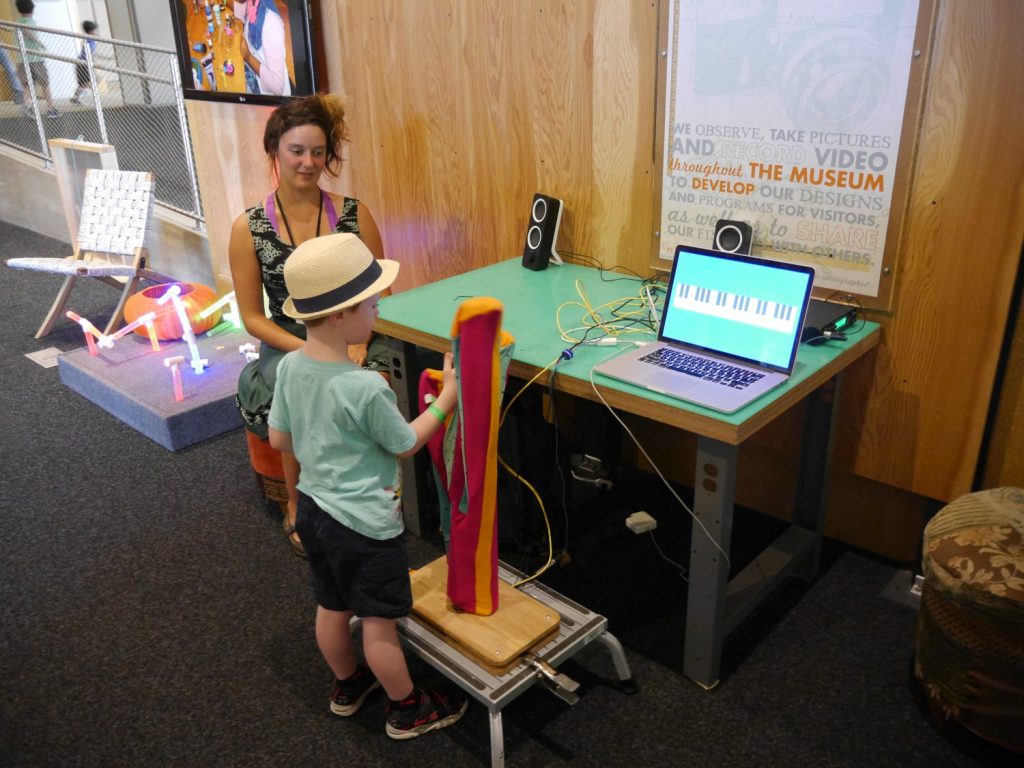
Coined “Tough Art,” we approached the residency as an experiment: we invited four local MFA students working in sculpture and interactive media to spend the summer at the Museum, create an original artwork, and participate in a group exhibition in the fall. Each artist received $3,000 from the Museum’s general operating funds to develop their piece. They worked independently, observing visitors, testing prototypes, and ultimately fabricating and installing their artworks in the Museum’s changing exhibits gallery. Throughout the process, the Museum’s exhibits staff provided technical support and advice, sharing their firsthand experience of fabricating and maintaining exhibits in this environment.
At the Children’s Museum of Pittsburgh, prototyping involves everyone–artists, staff, and visitors. This is the time for artists to get to know the audience, observe their work in the real museum environment, and engage directly with visitors and staff before their artwork is complete. Prototyping can be an uncomfortable experience for an uninitiated artist; seeing people push, pull, or prod their creations in ways that would be forbidden in a fine art museum can be unsettling. However, it presents an opportunity for staff and visitors to ask the artists questions that they might not have considered on their own. Throughout the residency, artists are strongly encouraged to embrace misfires and mistakes as part of the process because these “failures” can lead to inspiration, innovation, and a better result in the end (fig. 3).
Budget Facts: How Much Is Enough?
The experiment worked: each artist produced an original artwork with input from staff and visitors that resulted in a three-month exhibition. We demonstrated that it was possible to take an artwork from concept to installation in 12 weeks for $3,000. Energized by this experience, the staff refined the Tough Art model and secured federal funding from the Institute of Museum and Library Services (IMLS), Museums for America granting program to host the residency for another three years. At this time, the residency became a formal program within the Exhibits Department, with the Museum’s process of iterative prototyping becoming a central aspect of the program structure.
Budget Baseline
Tough Art went out as an open call in January 2008, soliciting applications from artists across the country for that summer. The annual budget was $40,000, with each of the four participating artists receiving a $4,000 stipend, paid in three installments, and an additional $2,500 for materials. When an out-of-town artist was selected, we adjusted the budget to cover housing and travel expenses for the duration of the three-month residency. The remaining $14,000 covered the Museum’s operational expenses, including salaries, marketing, and general exhibition expenses like signage.
Over the next three years, we learned more about how to run the residency and how it fit into the culture of the Museum. At the same time, Tough Art was gaining recognition in the arts community, expanding our applicant pool. In 2008, we had 10 applications and selected our first out-of-town artist. By 2010, we had more than 20 applications and selected our first artist team. By the end of the IMLS grant in early 2011, we had commissioned 12 artworks, worked with 13 artists, and staged three exhibitions.
Most importantly, Museum staff were committed to the process, confident in the results, and ready to keep going. When the grant ended, the residency’s expenses were absorbed into the annual operating budget. The Tough Art budget basically remained unchanged for 11 years, following the original model of a $4,000 stipend and $2,500 for materials per artist. When there weren’t any housing or travel expenses, we reduced the budget accordingly. Some years, we accepted artist teams, with two people applying to the residency as a pair. In these cases, we did not alter the budget: artist teams shared the stipend and had the same materials budget as solo artists.
Increases for Our Artists
In 2018 we adjusted the budget, increasing the stipend to $5,000 and the materials budget to $3,000. Yet, we held our bottom line steady at $40,000 by only hosting three artists instead of four. At the time, it was clear that increasing the individual stipends was important–both to keep up with the cost of living and to acknowledge the skill level of the artists who were applying to the program. Material costs were also higher in 2018 than they had been in 2008, and it was time we adjusted the budget accordingly. But just as living and material costs had increased, so too had the Museum’s operational expenses. Reducing the number of participants ensured the overall quality of the program and allowed us to pay artists more without requiring an increase to our overall operating budget. This change also resulted in staff having more time to work with each of the three selected artists. These budget decisions were made after 10 years of experience with the residency had revealed to us how best to strike a balance between frugality, creativity, and reality.
Pandemic Changes: New Reality, New Budget
When the Museum closed in 2020 in response to the global pandemic, we were determined to continue the Tough Art program, so we developed an online version: Tough Art @ Home. The premise was the same–ask artists to share their process and practice, give them the opportunity to work closely with our staff to better understand how best to present their work to a family audience, and present an engaging, interactive art experience at the end of the summer. With a total budget of just $1,000, we held an open call for artists to develop an art activity that related directly to their practice and could be presented on the Museum’s website.[1] We selected five artists from a pool of 50. Each artist was given $200. The scope of the project included two one-hour online meetings with staff to plan the project and a PDF with a short instruction video. Even though the compensation was modest, we were overwhelmed by the response from artists who were eager for opportunities to continue to share their art while we were all locked down.
Although the Museum was open to the public in the summer of 2021, we were not in a position to host an in-person residency, so we repeated Tough Art @ Home, this time increasing the stipend to $300 per artist. The experience was again worthwhile because it held true to the core mission of the program–providing our audience with new art experiences and helping us think differently about our work.
By 2022, we were eager to resume the in-person residency because we missed having the artists on site working with our staff and visitors. Tough Art often has the energy of a summer camp, with that mix of excitement and nervousness that comes from meeting new friends and trying new things. We returned to our 2018 model, with three artists each receiving a $5,000 stipend and $3,000 for materials.
Embrace the Idea that This Is Temporary
The residency is structured to create temporary works of art. Having a relatively small budget and tight schedule helps to limit the scope, which means we can refresh the galleries more frequently than we might if we had invested a lot of time and money in a new exhibit. We believe being willing and able to change the exhibits regularly keeps the Museum fresh for visitors and challenges our staff to experiment with new ideas.
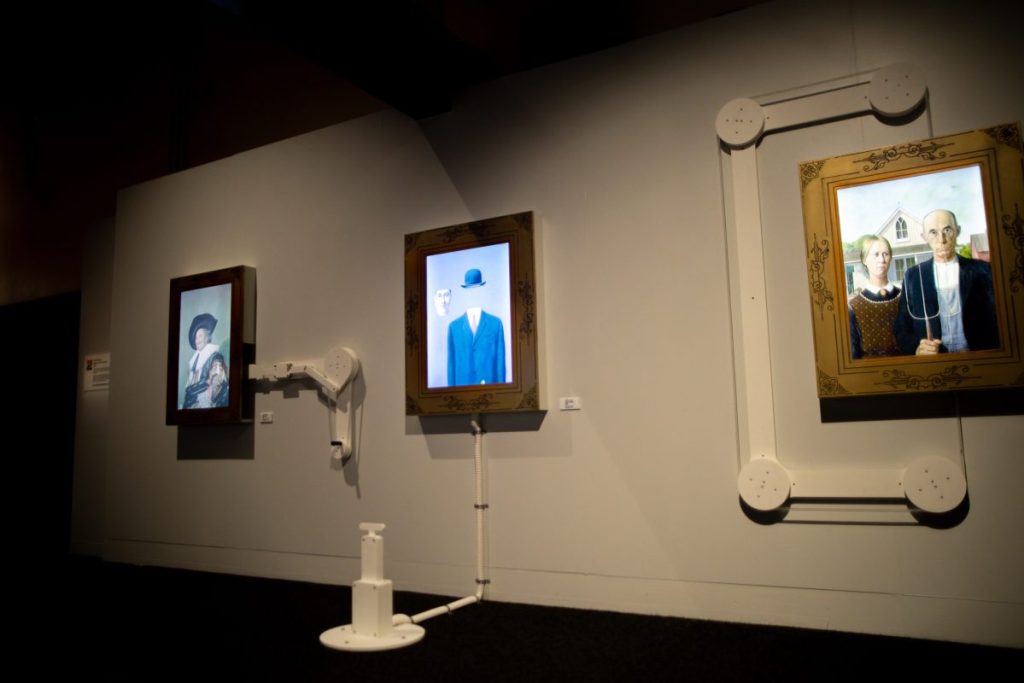
Most of the Tough Art installations are deinstalled after three months and stored for possible future reinstallation. However, some of the artworks are left in place for another three months or longer, depending on the location, condition, or content of the artwork. The biggest determining factor in how well any artwork will function as a more permanent piece is how robust it is and if visitors like it. If a Tough Art piece does become a long-term installation, we add money to our annual operations budget for its maintenance (fig. 4). We currently have nine Tough Art pieces in this category with another five available to rotate into the Museum periodically. We also continue to host the 10 Tough Art @ Home projects online.
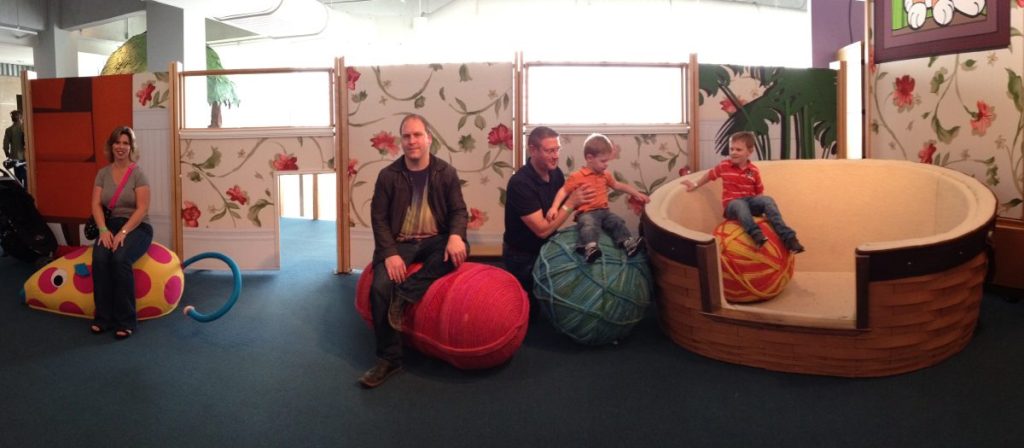
What happens if an artwork doesn’t hold up? Was it still worth the investment? For us, the answer is a resounding yes. Some artworks fall apart and need to be removed after only a few days of active use by visitors. Even in these extreme situations, we don’t consider the work a failure or a misuse of resources. Instead, we look at this as a part of the process. When you take chances, sometimes it works and sometimes it doesn’t. By limiting the materials budget, everyone can stay focused on quick, creative solutions, and you can afford to move on if it just doesn’t work.
Get Everyone Invested in the Process
Weekly meetings between artists and staff are key to working with a limited budget and help to avoid unwanted surprises. If an artist’s vision exceeds their budget, it is important to catch it early and be ready to offer alternatives. Sometimes, the Museum can provide in-kind resources, like materials, to get a budget back on track. We have also contacted vendors to see if they can reduce prices or even offer a donation. It is surprising how often people want to help, especially when they know it is for an artist or children’s museum. A notable example was when Longaberger Baskets, a basket manufacturer in Ohio, fabricated a custom version of their iconic basket into an oversize cat bed for the installation Kitty Kiddie Meow Meow (2012) (fig. 5). While a donation of this value is rare, it speaks to what is possible when you look at project budgets creatively and are open to unexpected solutions.
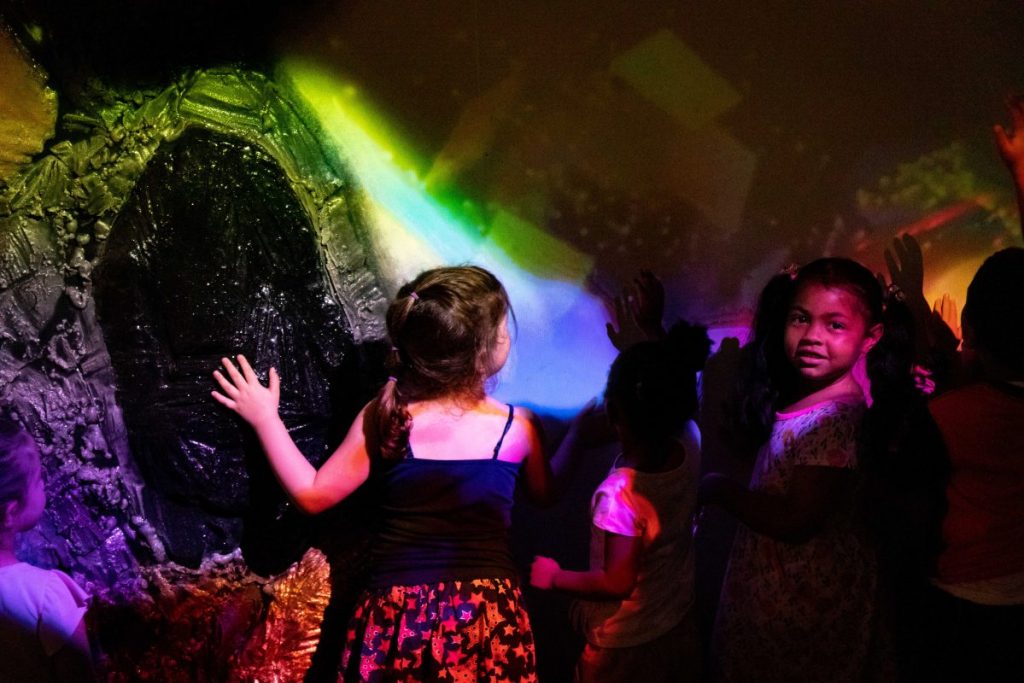
It is important to bring the finance team into the project early and often. Budgets, schedules, and contracts can be sources of anxiety for creatives who want to focus exclusively on their art. Taking time to personally introduce the people who will be paying the artists and their bills, making it clear to everyone that they are as much a part of the project team as the exhibit fabricators, is a key part of the process and can ease anxiety all around. Provide the artists with resources like museum accounts, vendor lists, sample budget worksheets, and guidance about how your finance office works. Not only will this help the artists manage their budgets, but it will also help museum staff by creating a process that is more transparent, efficient, and empowering to all involved.
Balancing Consistency with Change
Fundamentally, after 15 years, the residency works. By providing financial support, programmatic structure, and an alternative setting for art, the residency offers artists the opportunity to think differently about their own practice. Even though the artworks in development are sometimes unfinished until the final moments before the exhibition opens, there is a consistency in the collection because all the artists:
- Go through the same prototyping process with our visitors in the same spaces the final artworks are located;
- Have access to the same resources (tools, materials, money), so there is a common scale and level of finish;
- Are mentored and supported by museum professionals.
Ultimately, the kids are the arbiters of success or failure. Details change; artists change; budgets change; but the fundamentals remain the same. The kids decide if the art is tough enough (fig. 6).
[1] To see the projects that resulted from this virtual residency, visit Children’s Museum of Pittsburgh, “2020 Tough Art @ Home,” https://pittsburghkids.org/exhibit/2020-tough-art-home/, and “2021 Tough Art @ Home,” https://pittsburghkids.org/exhibit/2021-tough-art-home.







